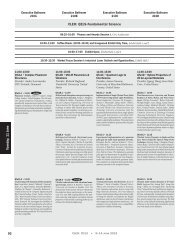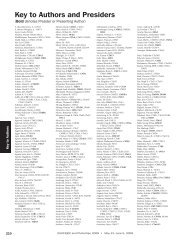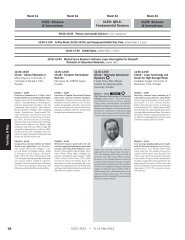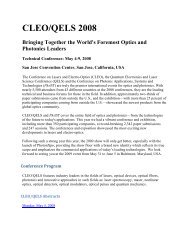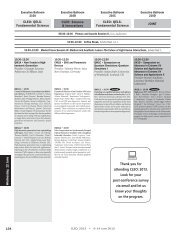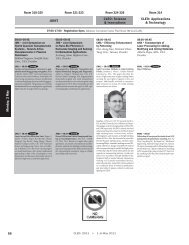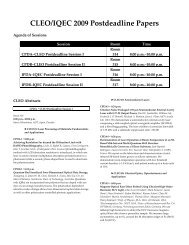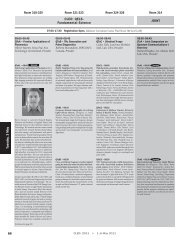You also want an ePaper? Increase the reach of your titles
YUMPU automatically turns print PDFs into web optimized ePapers that Google loves.
Room 336 Room 337 Room 338 Room 339<strong>CLEO</strong>IQECCMQ • Ultrafast OpticsApplications—ContinuedCMR • Optical CoherenceTomography—ContinuedCMS • Pollutant and EmissionSensing—ContinuedIMF • Quantum Information I—ContinuedCMQ5 • 11:15 a.m.Laser-Assisted Photoemission from SurfacesDriven by Long-Wavelength Infrared Light,Jing Yin 1 , Luis Miaja-Avlia 1 , Sterling Backus 2 ,Guido Saathoff 3 , Martin Aeschlimann 4 , MargaretMurnane 1 , Henry Kapteyn 1 ; 1 JILA, Univ. ofColorado at Boulder, USA, 2 KMLabs Inc., USA,3Max-Planck-Inst. of Quantum Optics, Germany,4Dept. of Physics, Univ. of Kaiserslautern, Germany.We demonstrate experimentally the advantages ofdriving laser-assisted photoemission from surfaceswith long-wavelength-IR light. We show that applicationsin probing surface dynamics benefitfrom using longer-wavelengths since many sideeffects of strong fields are suppressed.CMR2 • 11:15 a.m.Effective Indicators for Oral Cancer DiagnosisBased on Optical Coherence Tomography,Meng-Tsan Tsai, Cheng-Kuang Lee, Hsiang-ChiehLee, Yih-Ming Wang, C. C. Yang, Chun-Pin Chiang;Natl. Taiwan Univ., Taiwan. A swept-sourceoptical coherence tomography system is used toclinically scan oral precancer and cancer patientsfor statistically analyzing the effective indicatorsof diagnosis including the signal standarddeviation, spatial-frequency spectral shape, andepithelium thickness.CMS4 • 11:15 a.m.Characterization of Soot Aggregates Basedon Polarization Modulated Scattering, WeiweiCai 1 , Laura Kranendonk 2 , David J. Ewing 1 , LinMa 1 ; 1 Clemson Univ., USA, 2 Fuels, Engines, andEmissions Res. Ctr., Oak Ridge Natl. Lab at NTRC,USA. A sensor is demonstrated to characterizesoot aggregates based on polarization modulatedscattering. Comparison with other techniquesshows promising agreement, and extension ofthe sensor to 1- or 2-dimensional soot imagingis discussed.IMF3 • 11:15 a.m.Microcavities for Cavity-QED in Single-CrystalDiamond, Paul E. Barclay, Charles Santori,Kai-Mei C. Fu, Raymond G. Beausoleil; Hewlett-Packard Labs, USA. Optical microcavites fabricatedby etching whispering gallery mode andphotonic crystal structures in a high-index galliumphosphide layer and an underlying single-crystaldiamond substrate are studied experimentallyand theoretically.CMQ6 • 11:30 a.m.Heterodyne Optical Sampling for PicosecondUltrasonics and Nanoscale Heat Transfer, EricMottay 1 , Pierre Rigail 1 , Christophe Pierre 2 , SebastienErmeneux 2 , Clement Rossignol 3 , Jean-Michel Rampnoux3 , Stefan Dilhaire 3 ; 1 Amplitude Systems, France,2Alphanov, France, 3 Univ. of Bordeaux, France. Wepresent a novel ultrafast pump-probe system, allowingfor a drastic reduction in acquisition time,typically a few tens of minutes for 20,000 frames.We present acoustic waves and heat transfertmeasurements in nanometric layers.CMR3 • 11:30 a.m.Fourier Domain Pump-Probe Optical CoherenceTomography Imaging of Melanin, DesmondJacob, Ryan Lynn Shelton, Brian E. Applegate; TexasA&M Univ., USA. We report the first molecularimage of melanin using a novel extension ofOCT, pump-probe OCT. Melanin, an abundantendogenous chromophore, could provide generalcontrast in OCT imaging and means to diagnoseand/or monitor melanomas.CMS5 • 11:30 a.m.Multiple Gas Sensor Based on Super-LuminescentDiode for Combustion Monitoring, NileshJ. Vasa; Indian Inst. of Technology Madras, India.Fiber-coupled super-luminescent diode (SLD)based source for the detection of various gasesis proposed. SLDs with wavelengths of 760 nmand 1530 nm are used for sensing of O 2 and NH 3 ,respectively.IMF4 • 11:30 a.m. InvitedDemonstration of Two-Qubit Quantum Algorithmswith a Solid-State Electronic Processor,Leonardo DiCarlo 1 , Jerry Chow 1 , Jay Gambetta 2 ,Lev Bishop 1 , Johannes Majer 3 , Alexandre Blais 4 ,Luigi Frunzio 1 , Steven Girvin 1 , Robert J. Schoelkopf 1 ;1Yale Univ., USA, 2 Univ. of Waterloo, Canada, 3 TechnischeUniv. Wien, Austria, 4 Univ. de Sherbrooke,Canada. We present the experimental implementationof two-qubit quantum algorithms in a superconductingcircuit. Entanglement on demand,Grover searching and the Deutsch-Jozsa algorithmare demonstrated. Algorithmic performance isquantified via quantum state tomography.<strong>Monday</strong>, <strong>June</strong> 1CMQ7 • 11:45 a.m.Novel 2-D High-Contrast Grating Hollow-CoreWaveguide, Bala Pesala 1 , Vadim Karagodsky 1 ,Fumio Koyama 2 , Connie Chang-Hasnain 1 ; 1 Univ.of California at Berkeley, USA, 2 Tokyo Inst. ofTechnology, Japan. Hollow-core waveguides basedon high contrast gratings are analyzed using exactanalytical formulation. We obtain dispersiondiagrams and propose heterostructure geometryto confine the light two dimensionally in thesewaveguide structures.CMR4 • 11:45 a.m.In vivo Measurement of the Retinal MovementsUsing Fourier Domain Low CoherenceInterferometry, Kanwarpal Singh 1 , CarolyneDion 1,2 , Santiago Costantino 2,3 , Marcelo Wajszilber 2 ,Mark R. Lesk 2,3 , Tsuneyuki Ozaki 1 ; 1 INRS- EMT,Univ. du Québec, Canada, 2 Ctr. de Recherche del’Hopital Maisonneuve-Rosemont, Canada, 3 Univ.de Montréal, Canada. We describe an instrumentfor the study and diagnosis of glaucoma based onFourier domain low coherence interferometryfor the measurement of the retinal movements,to assess in real-time the biomechanical propertiesof the eye.CMS6 • 11:45 a.m.Real Time Ammonia Detection in ExhaledHuman Breath with a Quantum Cascade LaserBased Sensor, Rafał Lewicki 1 , Anatoliy A. Kosterev1 , Yury A. Bakhirkin 1 , David M. Thomazy 1 ,Jim Doty 1 , Lei Dong 1 , Frank K. Tittel 1 , Terence H.Risby 2 , Steven Solga 3,4 , Deborah Kane 3 , TimothyDay 5 ; 1 Rice Univ., USA, 2 Johns Hopkins Univ.,USA, 3 St. Luke’s Hospital, USA, 4 Johns HopkinsUniv. School of Medicine, USA, 5 Daylight Solutions,USA. Quantum cascade laser based breath sensorplatform for medical applications employing aquartz-enhanced photoacoustic spectroscopytechnique is reported. The detection sensitivityfor exhaled ammonia is at



